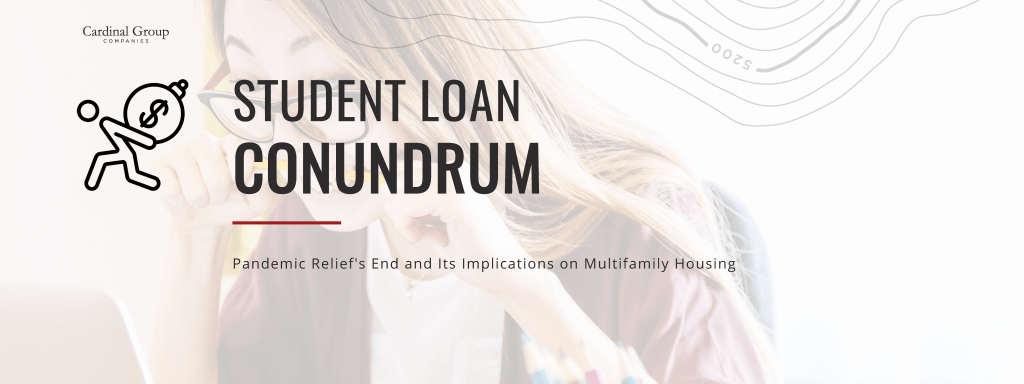The Student Loan Conundrum: Pandemic Relief’s End and Its Implications on Multifamily Housing
As we continue to grapple with a potential recession and combating rising inflation, another financial tempest may be on the horizon – the resumption of student loan repayments. Student loan debt in the United States has reached staggering levels, with over 43 million borrowers collectively owing more than $1.6 trillion in student loans. With millions of borrowers expected to resume their monthly payments, there are concerns about how this could impact various sectors of the economy. While it may seem unrelated to the housing market at first glance, the truth is that student loan repayments resuming could have a significant impact on the multifamily sector, as it could lead to an increase in delinquency rates and potentially elevate the risk for multifamily owners and investors.
THE STUDENT LOAN REPAYMENT DILEMMA
When the COVID-19 pandemic hit, the U.S. government introduced a temporary pause on federal student loan repayments, initiated by the CARES Act in March 2020 and subsequently extended. This pause provided much-needed relief to borrowers facing financial hardships and for many, this meant extra cash in their pockets that could be allocated to essential expenses, including rent. However, as of September 2023, loans resumed accruing interest rates with repayments due in October. According to Moody Analytics, as many as five million student loan borrowers will need to resume making payments close to $275 a month, on average. For many of these borrowers, student loan payments represent a significant portion of their monthly expenses, which could lead to a series of financial challenges for them, including:
- Reduced Disposable Income: The resumption of student loan payments will reduce the disposable income of borrowers. This could force some individuals to reevaluate their budgets, potentially cutting back on non-essential expenses, including rent.
- Increased Financial Stress: For borrowers with large student loan balances, the prospect of resuming payments can be stressful. This financial pressure may lead to delinquencies on other financial obligations, such as rent payments.
THE IMPACT ON MULTIFAMILY HOUSING
With the financial landscape for many individuals undergoing a significant shift, this change is poised to send ripples through the multifamily housing sector. As the financial weight of student loans is reinstated, multifamily communities may encounter a cascade of challenges ranging from higher delinquency rates to increased turnover and tougher leasing conditions, profoundly affecting both operators and residents alike.
- Higher Delinquency Rates: As borrowers wrestle with the renewed burden of student loan payments, they may prioritize these obligations over rent payments. This could lead to higher delinquency rates as residents struggle to make ends meet.
- Increased Turnover: Some residents may decide to relocate to more affordable housing options or move back in with family to ease their financial burden. This could result in increased turnover rates, which can be costly.
- Reduced Demand for Class A: Borrowers with substantial student loan debt may prioritize affordability over luxury, impacting the demand for higher-end Class A multifamily units. Owners and operators in this segment may face higher vacancy rates or reduced rent growth.
- Rental Rate Pressures: As delinquencies rise and operators seek to mitigate risk, they may increase rental rates. This could have a cascading effect on affordability and make it even more challenging for potential applicants, including recent graduates, to find affordable housing. On the contrary, a flight to affordability may result in higher demand for Class B and C communities, causing rents in these asset types to increase.
With the resumption of student loan repayments, it is crucial for us to recognize the potential ripple effects it may have on sectors of the economy, including multifamily housing. While the exact magnitude of the impact remains uncertain, stakeholders should remain vigilant and proactive in managing the potential risks associated with an increase in delinquencies, and the financial pressure that this places on residents. By implementing proactive strategies and maintaining open communication with residents, we can better navigate the challenges that may arise as student loan repayments resume. In this uncertain landscape, preparation and adaptability will be key in ensuring the continued stability of the multifamily housing sector.


